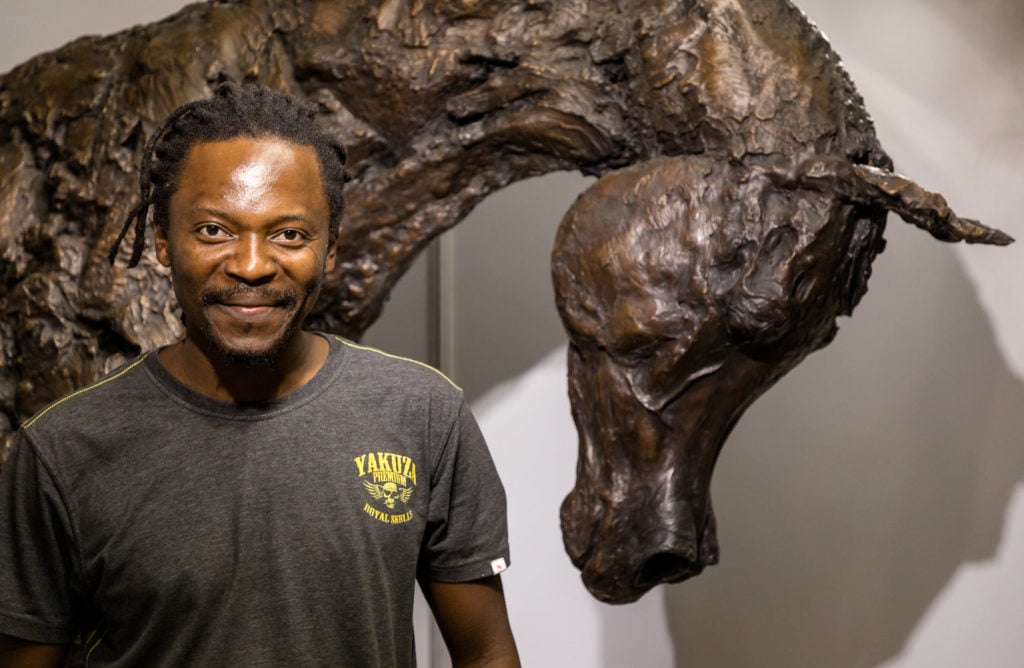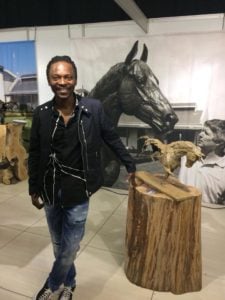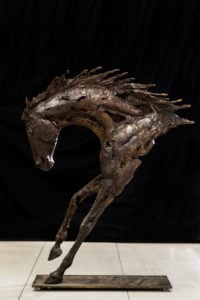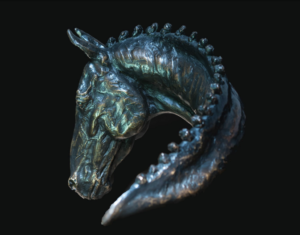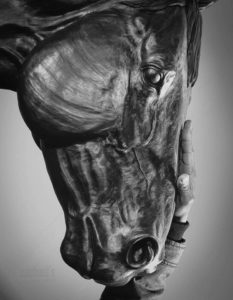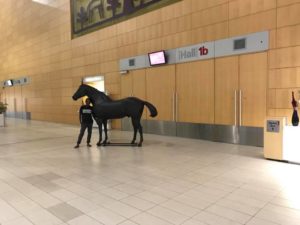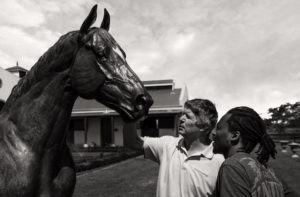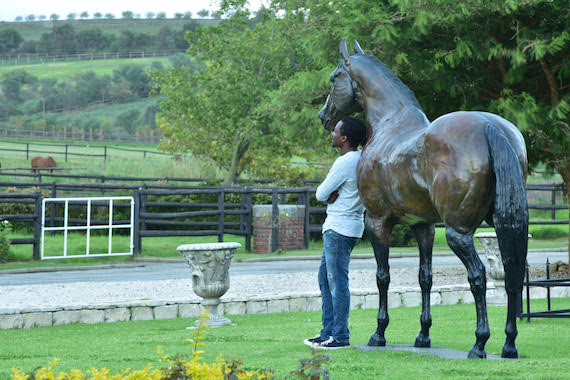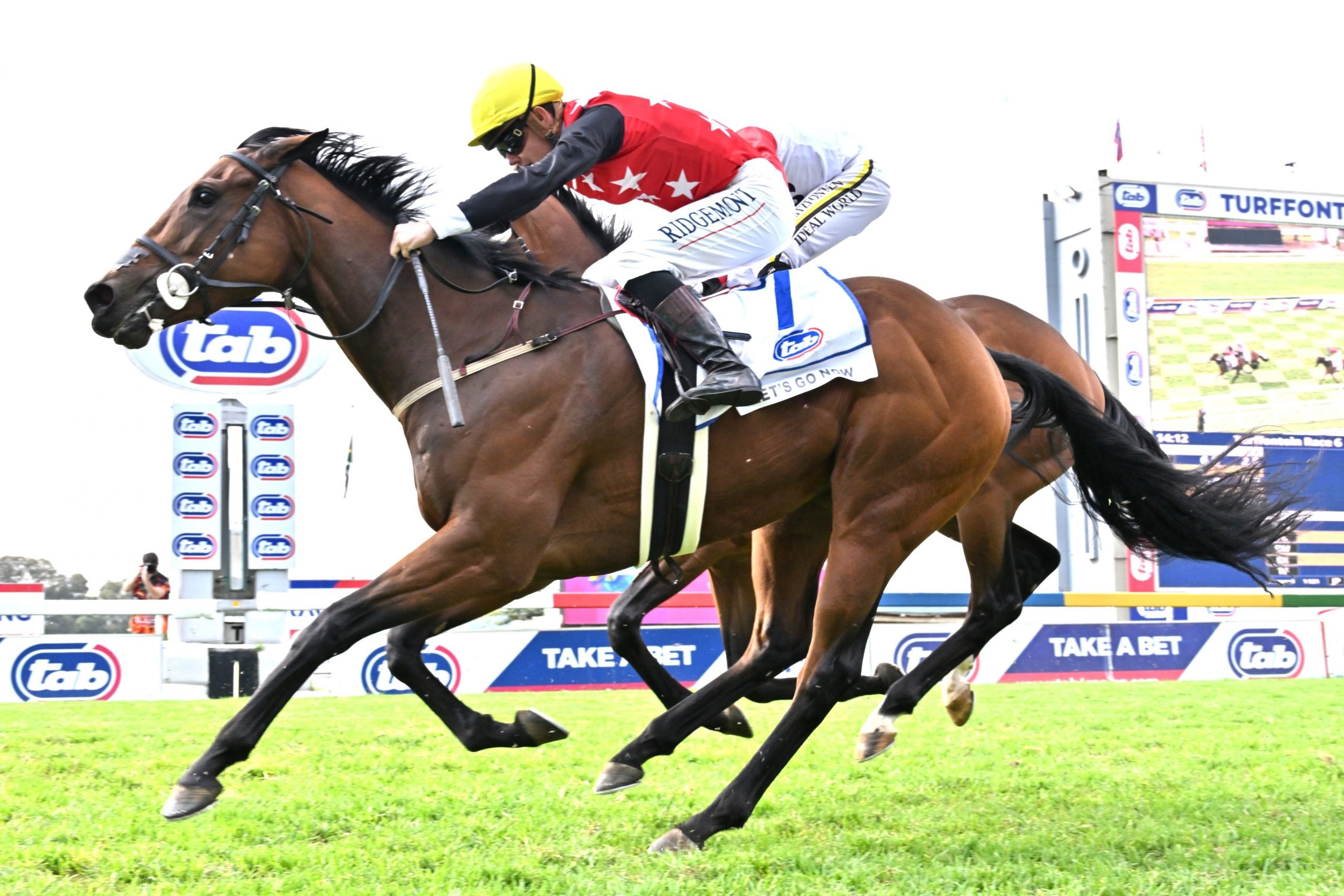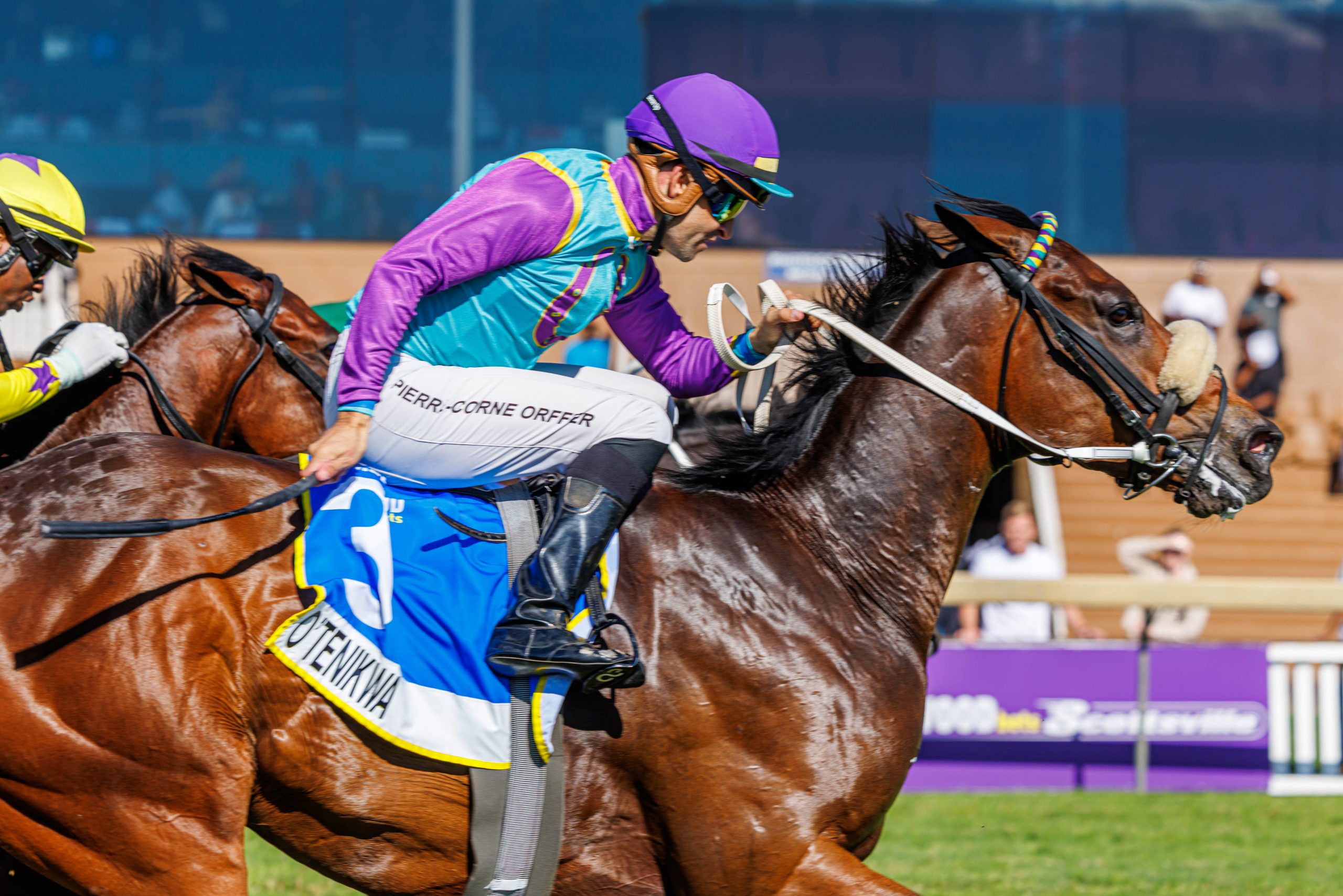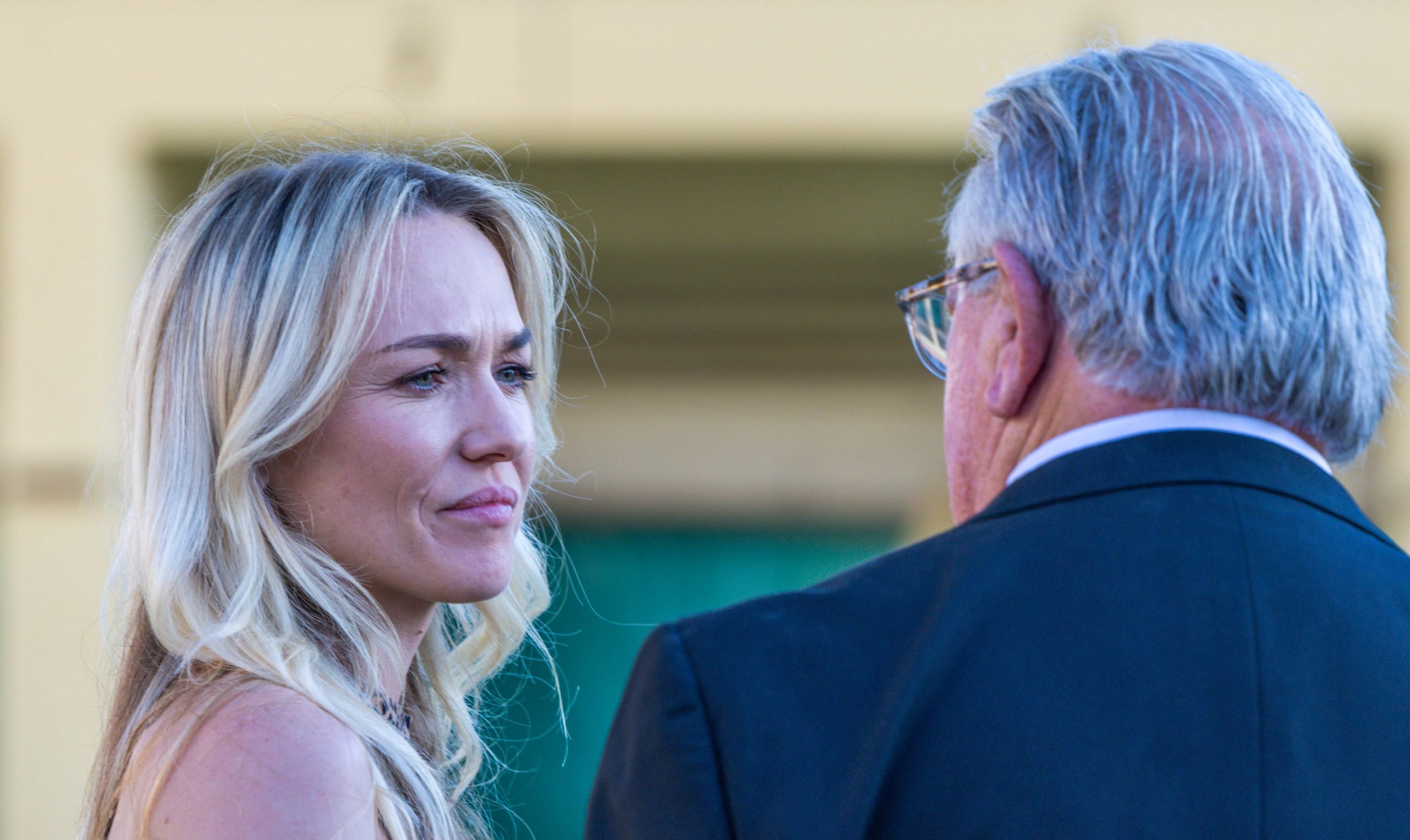Rugare Robin Kutinyu. You might not recognise the name, but if you’ve got any more than a passing interest in the local racing and breeding industry, you have definitely seen his work. In fact, he’s become such a fixture on the local landscape, that I was surprised to learn that he’s only been exhibited at sales for the past two years.
Robin is the man responsible for those fantastic life-size bronze horse sculptures in the foyer of the CTICC building at the last two Cape Premier Yearling Sales. He’s also exhibited at Monty Roberts’ Cape demos in 2016, a number of Klawervlei Farm Sales and one of his pieces greets you as you walk into the Candice Bass-Robinson yard. However, the piece that has most captured the hearts, minds and imaginations has been his wonderful life-size work of Captain Al, which was installed in pride of place at Klawervlei last December.
Close Encounters
Much like his work, Robin is better experienced than described. Manning his exhibition right at the entrance to the Cape Premier Yearling Sale stable yard, he has an irresistably broad, friendly smile which invites you to stop and chat and admire his work. Unlike his art works, often larger than life and brimming with energy and movement, Robin is not imposing in stature, but exudes an extraordinary calm, but intense focus.
About Robin
Robin is a second generation Zimbabwean, who followed his roots back to South Africa 15 years ago and applied for permanent residency. Robin learnt his craft as a young boy, studying alongside his father. “The only art I did at school was normal drawing, but that was in primary school. My father was an acclaimed sculptor who specialised in wildlife and also painted oils and I learnt everything from him. When I was 5 years old, I started messing around making horses and humanoid figures. He asked if I wanted to do what he did. My father was one of those people that if you get into something with him, you have to be 100% dedicated and apply yourself to the maximum. So at 5 years old, I started doing sculpture and sold my first work when I was 10. When I was not at school, I was home doing sculpture and I loved it and as soon as I left school I became a professional sculptor.”
How do you earn a living?
“I’ve been lucky enough to get in at an early age, and I guess it’s all about knowing how to come up with a system that works for you. You have to know how much you spend every year, you have to do all the budgeting to do it properly. You might not sell every month and sometimes you won’t sell anything for 6 months to a year. You need to know how to keep people engaged so that they want to buy. If you have foreign clients you need to know when they are visiting, how and what they like to keep them engaged and want to have your work as a collection, not just buy one off pieces. And from there hopefully they recommend their friends and refer other people. It’s not an easy thing, but you work out how to do it and work out when to invest money into doing this or that.”
Keeping it fresh
Robin works in a number of different mediums, including bronze, welded metal and stone and also does oil painting. “I’m very experimental and you need to ensure your work is always evolving, so people aren’t coming in and seeing the same thing. You want clients to think, ‘This is new, it’s evolved, I’d like to collect that as well’. They will introduce their friends and that hopefully leads to more work. Like with the Captain Al project, I’ll now look and see if anyone else might like to have their stallions done.”
“Part of what I’m doing at sales is coming up with ways of going to the clients so that I can show them what I have. You get to find out what they like as well. You always have to find out how to interest your clients and what they might like. Of course, at horse sales it’s quite a challenge. Art is an extra extra extra luxury and these guys are thinking about getting horses before investing in art.”
Portfolio
Robin is best known for his humanoid figures, African animals and endangered species and the majority of his work is sold abroad. “About 95% of my work is sold overseas and about 5% stays behind, either for a few private collectors or overseas clients to go in their holiday homes.”
Clients are many and varied, ranging from Tiger Woods’ mother, who commissioned two granite life-sized tigers in 2013 to the owner of a zoo in Canberra. “There is a lodge connected to the zoo and some of the rooms have ballistic glass that goes into a cave right into the animal enclosure. Their interior decorator wanted lampshades with African animals on the base. She took photos of some of the other pieces I had and the following day phoned to say her client wanted to buy everything. He now comes in on a yearly basis. So that’s how that one came about, but you have to find ways to get people like that who follow your work and want to collect it.”
Equine
Horses have been one of Robin’s favourite subjects since he was a boy, but he didn’t focus on it intensively until a chance conversation with a client named Rose Hall. “Rose started buying my work and collecting pieces a long time ago. One day she mentioned that she owned racehorses and offered to take me to her trainer, so she took me down to Mike Bass. I took my camera and they let me onto the track to take some shots. Rose also introduced me to Mike’s son Mark and after seeing some of my work, he said he had a friend who might be interested. About two years ago, just before the Klawervlei Farm Sale, he gave me a call out of the blue to say they were looking for a piece to auction for charity.”
“I gave them a small piece and an average sized piece, on condition that I could bring a few sculptures to exhibit. As I was unpacking, they changed their minds and bought a large piece for auction.” The piece was a huge hit and raised nearly R2 million for charity. The exercise also resulted in Chris van Niekerk purchasing a large sculpture that has been installed on Shamrock at Klawervlei’s conference centre up on the mountain.
The rest is more or less history and Robin has since changed his focus and now spends the majority of his time sculpting horses. “Pippa at Avontuur also bought from me at the auction and people started getting to know me. After that, I was introduced to Anne Dalton who told me about the big Cape Premier Yearling Sale and I had my first sale there in 2017.”
Special Project
Robin is perhaps most easily recognised for his wonderful, life-size pieces that we have grown to expect in the foyer of the CTICC in particular. “John Koster planted the seed at that very first Klawervlei exhibition. When I was setting up, he said ‘one thing you might want to look into life size realistic replicas – a lot of people would like to have their horses done’. So I said ‘I want to start with your horse, so let’s talk about Captain Al!’”
Robin went to the farm to meet, measure and study Captain Al. “After having talks with John about Captain Al, I went to see him and meet the horse to try and figure out what makes him special and what they look for in a Thoroughbred to make a champion. I also wanted to understand John’s connection with Captain Al, because he loved that horse. I picked up a lot of information and started building my template towards the end of 2016. The next time they did an auction, I took ‘Captain Al’ to Klawervlei and when they saw it, they loved it.”
Robin had had to borrow a horse box to transport ‘Captain Al’ to Robertson, which created some fun and attention on social media. “People saw it on Facebook and loved the work. When I did the exhibit, people who saw the horse, loved it. A week or two weeks after that, the horse died. John called me and said I’ve got bad news and good news. I thought ‘oh no.’ He said Captain Al has died and that we needed to fast track the work.”
Robin made a mould from his master, set the bronze and added a few finishing touches and installed the finished product on 20 December 2017.
Pride of Place
When I delivered the work, it was super special. John came to visit and look at the sculpture a few days before I delivered the work, but that was the bare bronze and didn’t have the colours. I had it patina’d to give it the Captain Al colour and markings.”
“John was very emotional when it comes to Captain Al. He touched it like you would touch a real horse. For a second he grabbed his face and walked away. I think it was a little bit too much.”
The sculpture has been installed in front of the stallion complex. “John said it’s the perfect spot for him, looking down the road and protecting the farm as he always has. It wasn’t just a horse to him. He literally called Captain Al his brother.”
“Every time I work so hard and do special projects like that, you have to have an emotional connection to the work for it to work. I work very hard to get the feel of the animal. That’s why I do extensive interviews with the owner to get their feeling and their connection with the horse so that I can capture it for moments like that.”
“I’m so glad I managed to capture him. To be part of that and so much history – it was a good feeling.” Everytime now when he introduces me to anyone, he says ‘this is the guy who did Captain Al. He came in to see the picture we hung up in the background of my CTICC exhibition and he loved it. Every time he sees that and talks about the horse, it’s very special.”
Anyone interested in viewing Robin’s work or visiting his new studio at the Waterfront harbour in Cape Town, can get in touch via his website, https://www.robinkutinyu.com/


